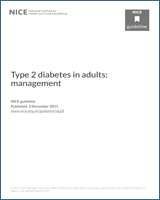All rights reserved. No part of this publication may be reproduced in any form (including photocopying or storing it in any medium by electronic means and whether or not transiently or incidentally to some other use of this publication) without the written permission of the copyright owner. Applications for the copyright owner’s written permission to reproduce any part of this publication should be addressed to the publisher.
NCBI Bookshelf. A service of the National Library of Medicine, National Institutes of Health.
This publication is provided for historical reference only and the information may be out of date.
Over 90% of people with diabetes have Type 2 diabetes. This is still perceived as the milder form, and while this may be true in some respects, such as the risk of ketoacidosis, the causation of Type 2 diabetes is more complex and the management is not necessarily easier. Type 2 diabetes can cause severe complications, affecting the eye, the nervous system and the kidney. The overall risk of cardiovascular disease is more than doubled, and life expectancy is reduced by an average 7 years. In 2002, NICE published a suite of five guidelines dealing with different aspects of the care of Type 2 diabetes. The rising prevalence of the disease, and the range of complications which can arise, reinforce the importance of up-to-date guidance and accordingly NICE have asked the National Collaborating Centre for Chronic Conditions (NCC-CC) to produce this guideline, amalgamating and updating the previously published work.
This is an update of the following NICE (inherited) clinical guidelines on Type 2 diabetes which were published in 2002: E – retinopathy; F – renal disease; G – blood glucose; H – management of blood pressure and blood lipids
The recommendations in this guideline on thiazolidinediones (R40 to R43, chapter 10), GLP-1 mimetic (exenatide) (R44 to R46, chapter 10) and insulin therapy (R49 to R55), chapter 11) have been updated and replaced by NICE short clinical guideline 87 ‘Type 2 diabetes: newer agents for blood glucose control in type 2 diabetes’ (available at www.nice.org.uk/CG87shortguideline). This short guideline contains details of the methods and evidence used to develop the updated recommendations. Chapter 10 and 11 should be read in conjunction with the short clinical guideline 87.
Contents
- MHRA advice on pioglitazone
- The European Medicines Agency (EMA) and rosiglitazone
- Clarification: Recommendation 81
- MHRA advice on aspirin
- Members of the Guideline Development Group
- Acknowledgements
- Preface
- Development of the Guideline
- The Guideline
- 5. Education
- 6. Lifestyle management/non-pharmacological management
- 7. Glucose control levels
- 8. Self-monitoring of plasma glucose
- 9. Oral glucose control therapies (1): metformin, insulin secretagogues, and acarbose
- 10. Oral glucose control therapies (2): other oral agents and exenatide
- 11. Glucose control: insulin therapy
- 12. Blood pressure therapy
- 13. Cardiovascular risk estimation
- 14. Management of blood lipid levels
- 15. Antithrombotic therapy
- 16. Kidney damage
- 17. Eye damage
- 18. Nerve damage
- 19. Areas for future research
- References
- Appendix A Clinical questions and search strategies
- Appendix B Scope of the guideline
- Appendix C Health economic analysis of third-line therapy with insulins, glitazones or exenatide in Type 2 diabetes
- Appendix D The cost-effectiveness of treating to target compared to a fixed-dose statins in patients with Type 2 diabetes
- Appendix E Declarations of interests by Guideline Development Group members
- Evidence Tables
Royal College of Physicians: The Royal College of Physicians plays a leading role in the delivery of high-quality patient care by setting standards of medical practice and promoting clinical excellence. We provide physicians in the United Kingdom and overseas with education, training and support throughout their careers. As an independent body representing over 20,000 Fellows and Members worldwide, we advise and work with government, the public, patients and other professions to improve health and healthcare.
National Collaborating Centre for Chronic Conditions: The National Collaborating Centre for Chronic Conditions (NCC-CC) is a collaborative, multiprofessional centre undertaking commissions to develop clinical guidance for the National Health Service (NHS) in England and Wales. The NCC-CC was established in 2001. It is an independent body, housed within the Clinical Standards Department at the Royal College of Physicians of London. The NCC-CC is funded by the National Institute for Health and Clinical Excellence (NICE) to undertake commissions for national clinical guidelines on an annual rolling programme.
Suggested citation:
National Collaborating Centre for Chronic Conditions. Type 2 diabetes: national clinical guideline for management in primary and secondary care (update). London: Royal College of Physicians, 2008.
- Review Type 2 Diabetes: Newer Agents for Blood Glucose Control in Type 2 Diabetes[ 2009]Review Type 2 Diabetes: Newer Agents for Blood Glucose Control in Type 2 DiabetesCentre for Clinical Practice at NICE (UK). 2009 May
- Review Interim Process and Methods Guide for the Clinical Guideline Updates Using Standing Committees Pilot Programme 2013[ 2013]Review Interim Process and Methods Guide for the Clinical Guideline Updates Using Standing Committees Pilot Programme 2013National Institute for Health and Care Excellence. 2013 Oct 14
- Review Key recommendations and evidence from the NICE guideline for the acute management of ST-segment-elevation myocardial infarction.[Heart. 2014]Review Key recommendations and evidence from the NICE guideline for the acute management of ST-segment-elevation myocardial infarction.Harker M, Carville S, Henderson R, Gray H, Guideline Development Group. Heart. 2014 Apr; 100(7):536-43. Epub 2013 Sep 5.
- Review Newer Agents for Blood Glucose Control in Type 2 Diabetes (Supplement)[ 2009]Review Newer Agents for Blood Glucose Control in Type 2 Diabetes (Supplement)Waugh N, Cummins E, Royle P, Clar C, Marien M, Richter B, Philip S. 2009 May
- Review Violence: The Short-Term Management of Disturbed/Violent Behaviour in In-Patient Psychiatric Settings and Emergency Departments[ 2005]Review Violence: The Short-Term Management of Disturbed/Violent Behaviour in In-Patient Psychiatric Settings and Emergency DepartmentsNational Collaborating Centre for Nursing and Supportive Care (UK). 2005 Feb
- Type 2 DiabetesType 2 Diabetes
Your browsing activity is empty.
Activity recording is turned off.
See more...

